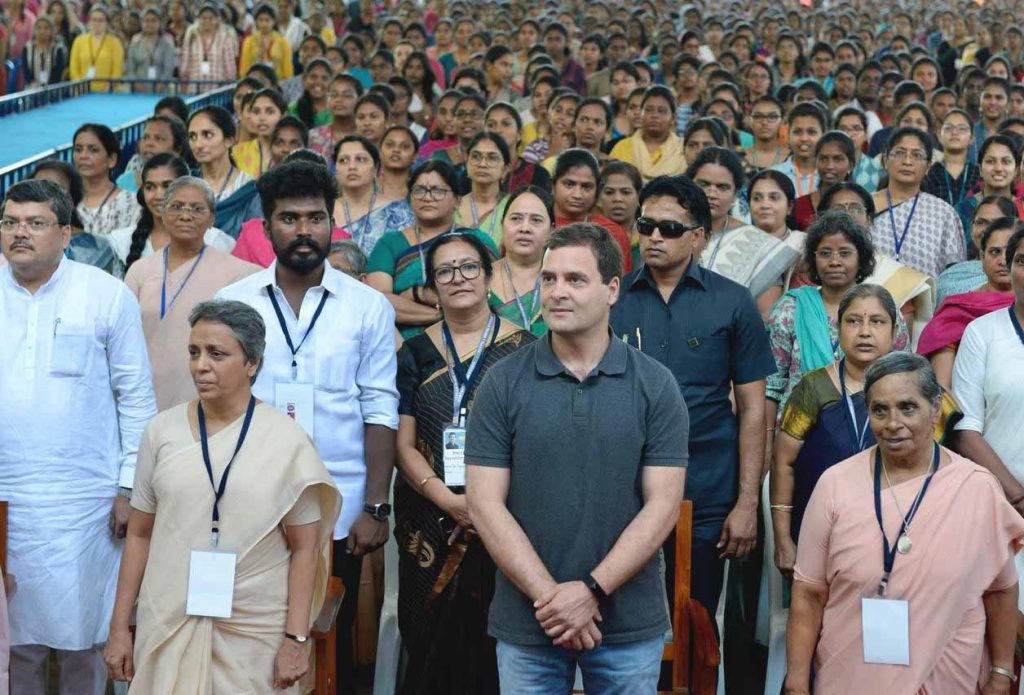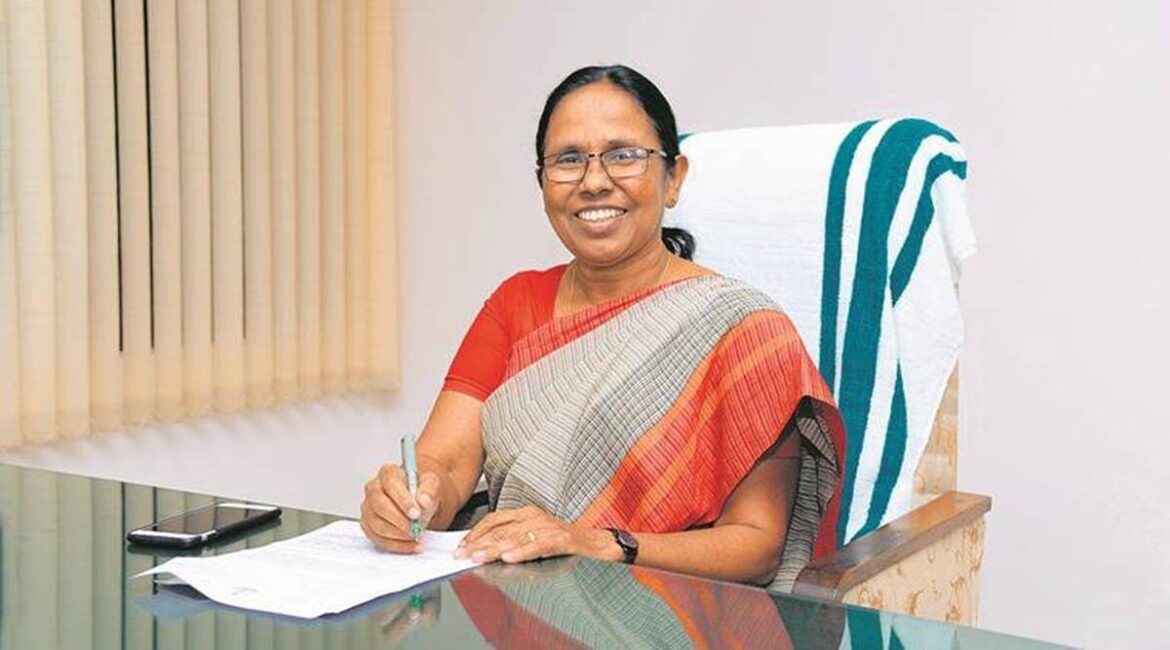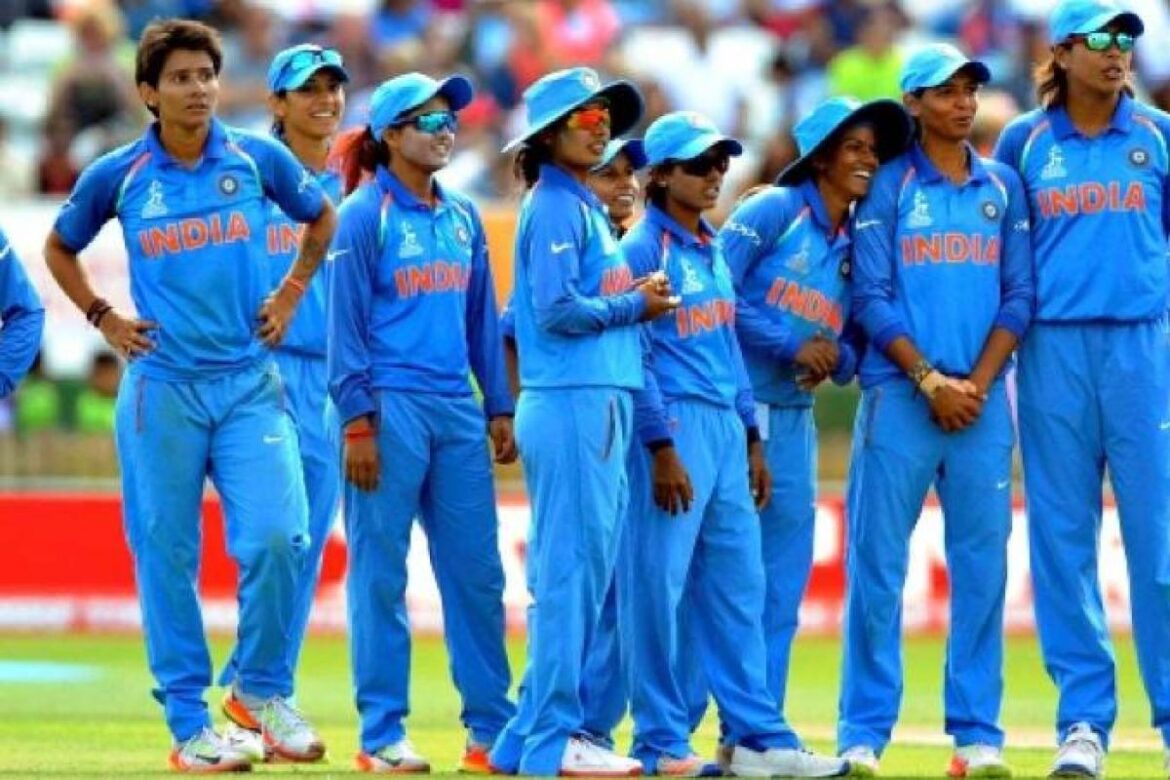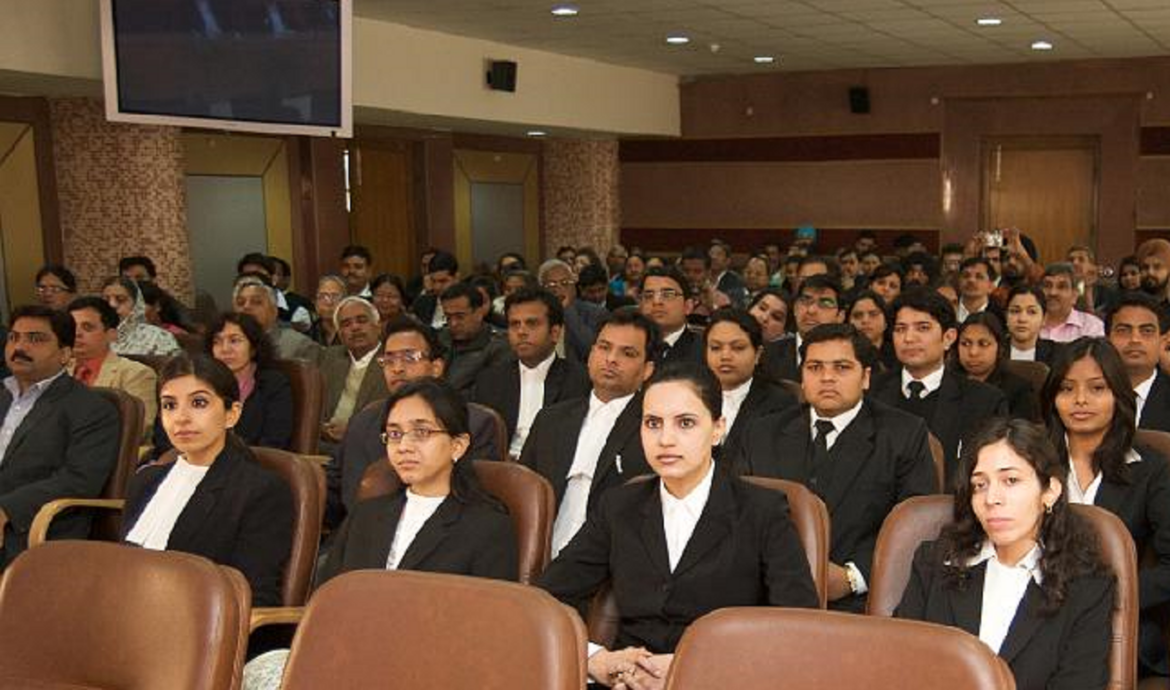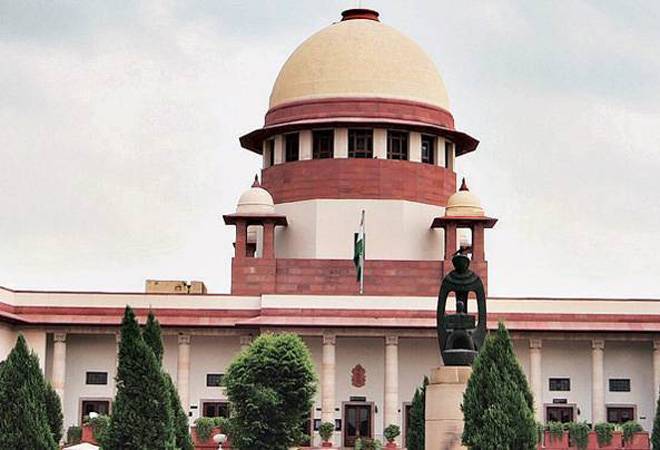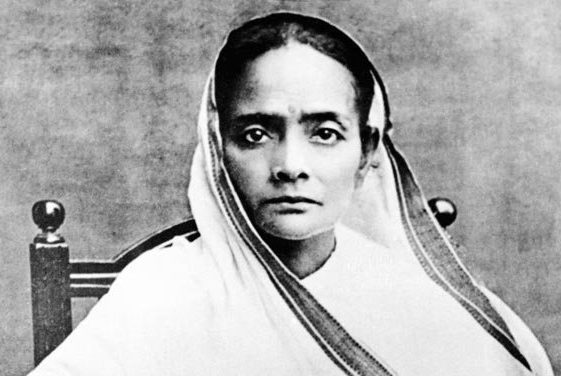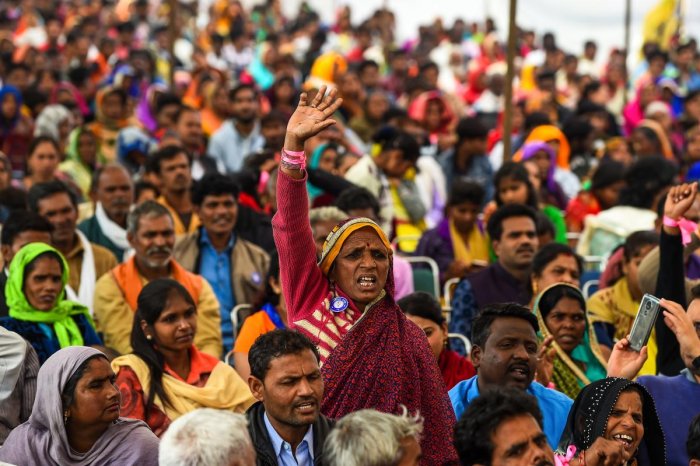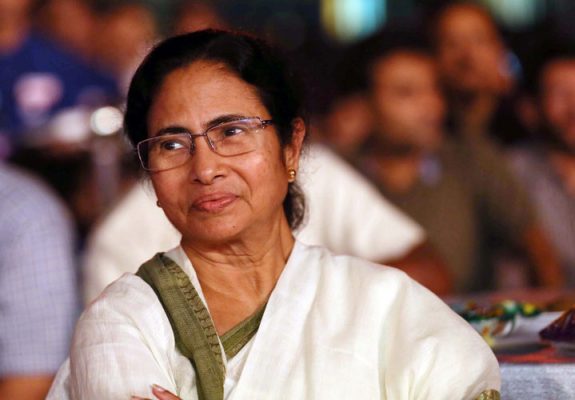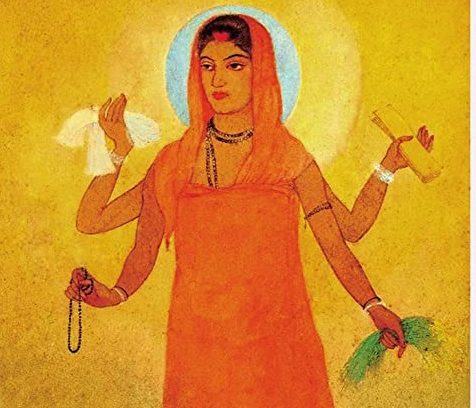India heard Rahul Gandhi say “If somebody is harassing you, if somebody is not giving you what is your due, you have to face them and challenge them” at the Bharathidasan college for women in Puducherry. India watched him teach some moves of Aikido, a form of martial art to the students of St. Teresa College for Women in Kerala after asserting ‘women are much more powerful than men are but they fail to understand their power.’ India feels 33 percent reservation in government jobs for women and the passage of Women’s Reservation Bill securing 33 percent seats in Parliament is possible only with Rahul at the helm. True to the quote “When thou doest alms, let not thy left hand know what thy right hand doeth: that thine alms may be in secret…” Rahul attempted an actual action to assuage the fears and misery of Nirbhaya’s family. When parties and leaders won’t miss an opportunity to paste their photos or symbols on stuff they donate, thereby flaunting their philanthropy, there existed a leader with class who pleaded with the recipients of his goodwill that his act remains a secret. Congress aligning with DMK is a good sign or omen especially for women because it’s a party molded by Muthuvel Karunanidhi, both a product and a creator of the Dravidian movement who ensured his progressive social policies made way towards significant social development in TN. For instance women’s welfare measures such as the Anjugam Ammaiyar Inter-caste Marriage Assistance Scheme, Dr. Dharmambal Ammaiyar Memorial Widow Remarriage Scheme, Moovalur Ramamirtham Marriage Assistance scheme, EVR Nagammaiyar Memorial Free Graduate Education for Girls Scheme and the Dr. Muthulakshmi Reddy Memorial Maternity Assistance Scheme were were initiated and implemented successfully.
Tamilnadu is buzzing ever since Rahul Gandhi set foot here because he represents a hopeful future for ‘Bharat Mata’ as a whole. Whatever he did with whoever, he looked more than endearing with gestures that revealed who he is and what he will be. He could blend effortlessly and his desire to make society more fair and equitable, with economic possibilities for all, was visible in his conversations and programs.
In terms of leadership style, Rahul has introduced “charisma” into the political equation. He has a strong rapport with the public and he understands how to use the media to shape public opinion. More so, elections look like they are based more on the individual than the political party. No doubt Rahul has inherited his father’s charm. When people voted the Congress to victory in 1984, they were generally casting their vote for Rajiv Gandhi the man instead of for him as the standard-bearer of the Party. The most popular Prime Minister up to his time, Rajiv used his enthusiasm to shape issues, and to mold opinions too.
Educational institutions welcomed him with ease. Rahul interacted ever-so-casually with students just to kind of hear from them, find out what they’re interested in, because he believes that most of the problems that we have are going to be solved by young minds. In his every move he was setting an example and to his critics he certainly looked like an important symbol of progress. It wasn’t an abstraction as Rahul witnessed the students in action, some impatient with events/things not in their control, few angry over losses and many sad about the existing structural inequities He recognized a part of him in them and he took it on him to help them understand a little bit more about how government works and explained how difficult it is to move this society forward without the right leadership.
At Xavier’s college, Tirunelveli the congress president made it clear that the real significance of what we do and achieve on the educational front must be reflected, not in statistics, but in the experiences of individual Indians, young and old, whose lives are supposed to be shaped by new educational programs and policies which should be formulated in tune with the needs and demands. Yet for the progress if any, we still face enormous problems in education: stubborn, lingering, unyielding problems because the policies are drafted by those who aim to use education as a “means for ideological indoctrination”. Interactive sessions highlighted Rahul’s skills as a good listener. Patiently did he listen and with all due honesty he clarified doubts and instilled hope. Definitely, connections that tie the government and the governed are primarily widespread public pessimism about the ability of the ruling government, at pretty much every level was heard and seen. Rahul’s extempores and the manner in which he responded to the ‘Educators Meet’ stood in vivid contrast to Modi’s constant uptalk as he reads from a teleprompter, staccato clauses and Twitter outbursts. The soul of his sentences – the resonance and depth took people back to the good old days of Kingmaker Kamarajar when he said education is not a financial commodity and hence should be available to everyone. He reiterated that noble professions like farming, education and healthcare being turned into financial commodities for the benefit of a handful of cronies has led to drastic changes in how our society perceives the role of food,knowledge and health in human life. A true leader like Rahul knows and understands that a country’s identity is the fusing of millions of disparate stories into a singular vision- a welfare society. Gujarat burns again and it’s never a model state.
In Mulagumodu, the hamlet of the Bruges lace Rahul was modish, making friends with students, weaving an intricate lace with love, dance, Aikido, push-ups and promises. Compelling and inspiring were Rahul’s mannerisms. Intimidated by this man’s camaraderie, the miserable Tamil Nadu unit of the Bharatiya Janata Party on Thursday wrote to the Election Commission to restrain Congress MP Rahul Gandhi from campaigning in vain. Thus, a genuine reply to a student who was concerned about the lack of freedom of expression in today’s India looked like a threat to national security but not the disappearance of rafale files or student groups like ABVP that inflict violence on students and practice goondaism by people in the disguise of leaders.
‘Big moment’ with the Chefs of the Village Cooking Channel (VCC) was the acme of RaGa’s visit. Whether it’s the way he transformed into one of them to become a hands on cook or the way he pronounced the ingredients in tamil or the manner in which he made them feel that he had a connection with them listening to their dreams and helping them grow wings by offering to introduce his friend Sam Pitroda or showing his humorous side, RaGa did it in style with no pretence whatsoever. As opposed to the PM who tried to woo the tamilians by trying his best in vain to utter a few couplets that did nothing but give enough content for memes and jokes in Tamilnadu, Rahul brought back Tamilnadu’s spirit and it’s sense of optimism. Any vision is worth little if a leader doesn’t have the character–the wisdom and heart to see through people’s eyes, hear between words and beyond what was spoken. Just a Few hours with the village chefs and their voices played into Rahul’s deep sense of Tamilnadu’s history and his belief in the promise of democracy. Seated beside them as they relished the mushroom biryani, Rahul discussed big ideas. We aren’t in an age where no popular leader can any longer mingle with his fellow citizens, either to stir them or learn from them. Remember the ‘Big Drama’ enacted by A Shah who visited a Dalit family in Peretapalli in Nalgonda district in 2017 with a troop of media persons? According to reliable sources Shah’s food was prepared in the mango orchard of an upper caste landlord in a neighbouring village. Another similar wily act of Shah at West Bengal’s Bankura in 2020 during his visit to a tribal family’s house was disclosed by Chief Minister Mamata Banerjee. These days, any such gestures by the BJP are more likely to be staged than genuine. For the BJP-AIADMK alliance in Tamilnadu, this election has been a combination of ‘ache din aane wale hai’ promises or DMK pummelling and new Rahul Gandhi bashing. Many a time, they were confused as to which approach should take primacy. With Rahul’s courage and integrity that I think is the hardest and most demanding kind, I believe that neither line would work to optimum efficacy.
In every educational institution he visited, Rahul made sure that he infused a confidence in students that they are as qualified as anybody to talk about what is right and just, and trust themselves in that. Without fear, he felt free to describe what he truly thought about a whole range of issues and that’s Rahul for TN. What’s more adorable was that, amidst withering criticism from the BJP, Rahul remained calm and composed even as he discussed different points of power, levers and fasteners throughout our society that help determine one’s direction- towards real democracy.
After watching Jallikattu in Madurai, RaGa assured the people of being one with them when it comes to protecting the culture and language of Tamilnadu. Shaking hands, acknowledging smiles and gestures, that was part of how he managed to maintain perspective and take his work seriously, or running for victory seriously, but not take himself too seriously. Rahul Gandhi had a valid point on the sport and he made it only after watching it in person. Yes, Congress leader Jairam Ramesh was Environment minister in 2011 when the Ministry issued a notification banning the use of bulls as performing animals and that will never downplay Rahul’s display of support to farmers. Just so the BJP believes and asserts that the party Supremo can’t be held totally responsible for a minister’s decision or tweet, it would be wise on their part to think at least once before accusing others of double standards. Having discovered its oxygen supply is shut down by voters of TN, BJP seems to be on a desperate search for relevance. It’s attempt to pooh pooh Rahul Gandhi’s charisma should be perceived in this light. There cannot be a better example of duplicity than AIADMK’s claim that their alliance with BJP is only “electoral”. Mr. Chief Minister you can’t sail safe and untroubled with a partner who has a different ideology or destination in mind.
At the gathering of Micro Small and Medium Enterprises (MSME) representatives in Coimbatore, RaGa’s solidarity was unmistakable. People await a restructured/ reconceptualised Goods and Services Tax (GST) and ‘one tax, minimum tax’. From Skill India, Digital India, Make in India, Atmanirbhar [Bharat], entrepreneurs ended up nowhere which means out of 7.5 crore small entrepreneurs, almost 30% of enterprises are dead. After ruling for 7 years in succession, the BJP is expecting the voters to swallow two things: One, economic reforms and two, it’s image of being pluralistic. Tamilnadu rejects both. Accusing the present ruling party of superimposing the GST, RaGa made it clear BJP’s GST is designed to help large businesses. It’s not a secret that the affluent have creamed off reforms that the Modi government has implemented so far. Therefore Mr. Prime Minister, what kind of economic reforms and for whom?
Cameras have a way of capturing what a thousand words cannot. TN has seen and heard Rahul like never before. As far as the people of TN are concerned, Rahul is the much needed fillip to our ailing democracy. Unlike BJP-AIADMK leaders whose proclamations underline that they are not willing to be active participants in any questioning of the principles underlying farm laws, poverty, corruption, alcohol prohibition or human rights and possible impact upon a highly unhealthy and unequal society, Rahul is willing to rectify failures/ shortcomings and reform government-a long overdue task. Above all, Rahul admits all pogroms and riots are wrong and he never hesitates to apologize unconditionally if need be.
Rape, harassment and other forms of violence against women appear to have risen in India and more so blatantly after the ruling government and it’s allies make every effort at moral policing. The audacity of blaming victims stems from the fact that BJP considers Manusmriti as a source of law for women issues. DMK that rests on the dravidian ideology that educating and uplifting women will bring social balance and growth will undoubtedly fare better with Congress by its side. ‘Bharat Mata’ as an appellation will be justified if women of all states rise and shine. May the sun rise from the beautiful south and throw some light on other parts of India as well.
Eventually, a vigorous and vigilant government is the sine qua non of a healthy democracy. And I guess Tamilians know it better.
Dear Rahul, as you know women’s welfare and safety is a concern and much more work remains. Women are capable of creating history and a promising future with formidable grace, for sure. But ‘don’t let anyone stop you’.


